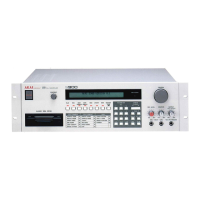14
COPY
(on© keygroup to another and
keep both in memory)
Point
arrow
at "Copy(+), Delete(—
)."
Press the + key then ENT.
The
copied
keygroup will
be
numbered
one digit higher than the
previously highest-numbered keygroup.
DELETE
(an existing keygroup)
Point arrow
at "Copy(
+)
, Delete(—
)
."
Press
the
—
key then ENT.
The
keygroup
will be removed from
memory.
IMPORTANT
INFORMATION
ABOUT PAGES 04 to 16
The LCD
shows the keygroup
number being edited below
each page
number. To
change keygroups at any time, point
the arrow
at
"KG—" and
use
CONTROL (or enter a two-digit
number with
the
0—9
keys) to select
the
new keygroup.
This
feature is
also
convenient
for efficiently adjusting identical
parameters for
various keygroups
with
a
minimum of
button-
pushing.
PAGE04VEL0CITY CROSSFADE,
VELOCITY
SWITCH THRESHOLD
•04
* V
e I
o c
I t
y
Crgsslldl ON
K
G
I iViitc i
ty
switch
threshold I
28
VELOCITY
CROSSFADE
This function
crossfades between the two samples of
the
key-
group
so
that
as
you
play harder,
the Soft
sample volume
gets
softer
and the Hard
sample volume gets
louder.
This provides
a
smooth
transition
between
Soft and Loud samples
as
you
play
with
greater or lesser
dynamics.
Point
arrow
at "Velocity Crossfade."
Press
ON/+ for velocity
crossfade on,
OFF/—
for velocity crossfade off.
VELOCITY SWITCH
THRESHOLD
As you
play
a velocity keyboard,
it
produces numbers that
corre-
spond to
your dynamics, with representing
a soft keystrike
and 1
28 representing a
hard keystrike.
You may
select any
number
between
and
1
28
with this
function. If the velocity
data is less
than the
selected
number, the Soft
sample will play.
If
the velocity
data is greater than the selected
number,
the Loud
sample will play.
Point arrow
at "Velocity switch threshold."
Use CONTROL to
select
the
desired switch point, or enter a three-digit
number
with the
0—9
keys.
Note:
A setting of 1
28
plays the Soft sample
only since it is not
possible
to play a note louder than 1 28. A setting
of
000
plays
the Loud sample only since
it is not possible
to
play
a note softer
than 000.
Playing
harder fades in
loud
sample and fades out soft
sample. With velocity switch,
there is
an abrupt transition from
soft sample
to hard sample at
the specified velocity.
Soft
VELOCITY
.
PAGE05I
SOFT
SAMPLE
RANGE
ASSIGNMENT
-ig5
Soft
*
s
am
p
i
#
•
KG I
SOFT
*
L o w Key
C0 24
(Hi (h K i
G8
I
27
Keyboard
assignment
determines
the
range (from
lowest
note to
highest note)
covered by a
sample.
Example: If you
have
a
sample
recorded at C3
(MIDI
note
60)
and want to
transpose it
plus and
minus one
octave, the
low note would be C2
(MIDI
note
48)
and the
high note
would be C4
(MIDI note 72).
If there is no
soft
sample,
which is the case if
velocity
threshold
=
(thus
precluding
the use of a
loud sample— see
Page
04),
the
LCD
will say "No
soft
sample,
vlcty thrsh
-
0."
1
.
Point
arrow at
"sample." Use
CONTROL to
select
the sample
to be
assigned
to
a
given
range of
the keyboard.
2.
Point arrow at
"Low
key."
Adjust CONTROL to
select
the
desired note,
or
enter the
three-digit MIDI note
number with
the
0—9
keys.
3. Point arrow
at
"High key."
Adjust CONTROL
to select
the
desired note,
or
enter the
three-digit MIDI note
number
with
the
0—9
keys.
lEAGE06
SOFT
SAMPLE LOUDNESS,
FILTER,
TRANSPOSE,
AND
FINE PITCH
—
^6
S
(Logdmss
*
F
i
I
t •
r
•
KSt I I
+
00
99
*Trinfpon
*fini
+00
+00
Loud
This
page edits
four soft
sample
parameters.
LOUDNESS (soft
sample
level adjust)
Each sample level
can be
adjusted by
itself (Edit Sample PAGE
03)
or as part of a
keygroup, as
in
this case.
Different
sections of
the keyboard can play
at
different
levels if
desired,
or samples
with unequal levels can be
balanced out
for uniform
keyboard re-
sponse.
Point arrow at
"Loudness." Use
CONTROL to increase loudness
above
the nominal +00
point (up to +50),
or decrease
loudness
below
the
nominal
+00
point (down to
-50).
Note: These fig-
ures represent arbitrary
volume
units,
not deciBels.
FILTER
(soft
sample high
frequency
response)
Low pass
filtering passes
low
frequency
sounds and attenuates
high
frequency sounds.
The
frequency at
which
the filtering
action occurs is
adjustable.
One
application
is to clean
up
noisy
samples
by
removing
high
frequency
hiss; also, filtering
inter-
acts
with filter velocity
sensitivity
(see
PAGE 1
0).
Point arrow at "Filter."
Use
CONTROL to
set
the
initial fiiter
fre-
quency or enter a
two-digit
number
with the
0—9
keys.
The
lower the number, the
lower
the
cutoff
frequency.
TRANSPOSE (soft sample
transposition)
Point arrow
at
"Transpose."
Use
CONTROL
or the
+,
-,
and
0—9
keys
to vary
transposition
amount
in semitones
from
50
semitones
up (+50)
to
50
semitones
down
(—50).
+00
gives no
transposition.
Note: Not atl samples
are
capable
of being transposed
over
the
full range.
FINE PITCH
(soft
sample
pitch)
Point
arrow at
"fine."
Use
CONTROL or
the
+,
-,
and 0-9
keys
to fine-tune the
sample
pitch up to
just
over
a
flatted
fifth
(+99)
or an equivalent amount
in
the
downward
direction
(—99). +00
gives no pitch
change.

